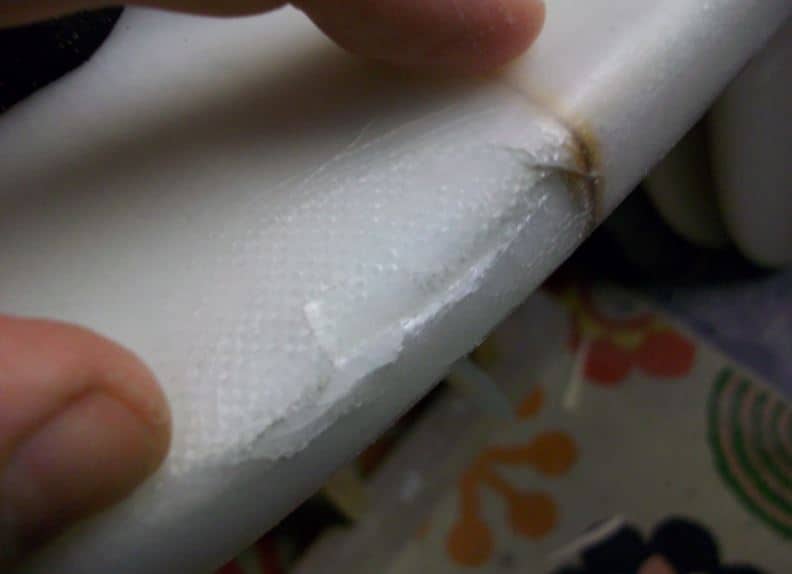It’s natural for a surfboard to show signs of use. If you stand in the same place when you ride, and you pop up and position your feet in the same place, you will get dents. After all, it’s a surfboard and the deck is made of foam or epoxy. Dings and cracks, though, are a different matter.
Should you surf with a ding in your surfboard? No, it is not a good idea to surf on a surfboard that has a ding or a crack in it. When there is a crack in the surfboard, water will get into the foam. This will damage the board and make it waterlogged. In this condition, the board will delaminate and eventually separate.
Is It Okay To Surf With A Dent In The Surfboard?
Dents are different from dings and cracks. Dents occur by standing in the same place when you position yourself on the board for a long period. As long as there are no cracks in the board inside the dent, then you can surf on it.
Dents are normal on epoxy boards. Lots of surfers have them. Experienced surfers use the dents to get a good foothold on the board. Your knees press on the board before popping up. You stand in the same place. Dents will occur naturally in these places.
What’s The Best Way To Repair Dings On A Surfboard?
This method of fixing dings and repairing dents takes longer and is intended for more serious dings and cracks. Move out into the sunlight to repair your surfboard. You need sunlight to help cure the resin you will apply to the dings and cracks.
Because of advances in resin formulation, the repair job should take less than 10 minutes to complete.
You will need
- Three varieties of sandpaper: one that is very coarse, a medium-coarse patch of sandpaper, and the least coarse type. A foam block usually contains the least coarse variety.
- A resin that’s cured by the sun. It can be either epoxy or non-epoxy resin, depending on whether or not you have a board made with epoxy. You can call the manufacturer of the surfboard or just go down to your local surf shop and ask one of the knowledgeable people there.
- An applicator preferably made of wood. If you don’t have one, you can use an ice cream stick since the cracks and dings are small.
- A few sheets of clear plastic.
- Perform ding repairs out of the sun.

Using medium-coarse sandpaper, sand down the ding. Rub lightly with the sandpaper to make it smooth against the surfboard and remove any rough edges.
Next, take the foam block least coarse sandpaper and smoothen it out further.
Apply the resin. One of the better resin products is Suncure Advanced Resin System. Suncure resin dries in a few minutes, so you don’t need to wait hours until the job is completed.
Now that the ding is ready, apply a fairly liberal amount of resin. Make sure you have the right kind – epoxy or non-epoxy – before you apply the resin. Use the wooden applicator and paste in on, making sure you cover it thoroughly.
If you have several dings, sandpaper all of them down and then apply the resin so they will dry at the same time. For bigger dings and cracks, use the coarsest sandpaper first, followed by medium coarsen and finally the finest sandpaper.
Next, take the clear plastic sheet to flatten the resin. Hold it flush against the ding and press gently. You can also tape it down with masking or duct tape to hold the plastic sheet snugly against the resin.
Bring the board out into the sun so the resin will cure and harden. Bright, midday sun is the hottest so the resin will cure quickly. It’s no problem to repair dings on your board early in the morning, on a cloudy day, or later in the afternoon on a sunny day. The resin will take a little longer to cure.
The more resin you use, the longer it will take for the resin to cure and harden. You can check the hardening and curing by lifting the plastic sheet off the repair. When it comes off smoothly and easily, you’ll know it’s done. We advise you to let it cure a little longer, even if the plastic comes off easily. Especially for deeper dings and cracks, you want to make sure it’s sanded all the way through the crack.

Lastly, use the coarsest sandpaper and smooth down the resin. Move next to the fine sandpaper. You’re done when you can no longer feel the ding and you can’t feel any more coarseness in the repair. It should be almost as smooth as the rest of the surfboard. There shouldn’t be any ridges on the sides of the patch.
Use the foamy very fine sandpaper block for the last once-over.
You’re ready to go surfing!
How Do I Repair Cracks?
You’ll need these supplies to repair a larger crack.
- Rough grit sandpaper
- A knife
- Coarse sandpaper and fine sandpaper.
- A resin that reacts to ultraviolet light.
- A spoon or a wooden spatula
- Q-Cell filler (optional)
- Plastic wrap
- An optional fiberglass sheet (Provides extra strength; recommended for larger cracks).
Surfboard cracks are a bit more serious than dings. Over time, cracks can ruin a surfboard’s structural integrity and result in a surfboard possibly breaking in half.
The first step is to wipe down the board using a damp cloth. This is to remove salt, sand, and surfboard wax. The board needs to be completely clean before repairing any cracks. Keep wiping until all the wax has been removed. Using a cotton swab, clean out the crank itself thoroughly because anything left inside the crack will make the repair weaker since the resin sticks to anything left there.
Now leave the board to dry overnight. This prevents the resin used in repairing the cracks from tapping water in the crack, which will cause mold to build up there. Once the board is completely dry, check out the inside of the crack to make sure there is nothing inside of it. You can even squeeze it to release any excess water that’s in it
Remove any foam that is inside the crack as well. Using a knife with a sharp edge, slice through the foam and pull it out.
Use very coarse sandpaper and sand down the crack. Sand all the way down to the fiberglass fabric. Sand the area around the crack too so the repair will be flat on the board. Once you see the fiberglass fabric under the board’s outer coating, you can stop sanding.
Use an ultraviolet-sensitive resin as you would for repairing a ding. Use one that is in liquid form so it can go deep inside the crack and adhere and harden it.
Mix the liquid resin with a Q cell filler. A Q cell is a hollow sphere used with resin that creates a smoother paste.
Pour 1 fluid ounce of resin and then place the Q cell into the resin. Wait until the resin has the consistency of a soft paste.
Use a wooden stick and apply the resin over the crack. Apply the paste resin out of the sun. Squeeze the resin into the crack until it’s full, then squeeze out any air bubbles inside the crack. Squeeze more resin into the crack afterward.
Cover the resin with plastic wrap and leave the crack out in the sun between 5 and 10 minutes.
Let the resin dry completely overnight and leave on the plastic wrap covering. Leave for up to 12 hours to dry.
Sand off excess resin. You can apply fiberglass to the resin if you’ve repaired a large crack. The fiberglass provides added strength to the area of the crack.
Related Questions
Should I Just Expect I’ll Get Dings And Cracks On My Surfboard?
Dings and cracks are inevitable. It comes with being a surfer. Expect dings regularly. Cracks will come too. Once you’ve repaired a ding or a crack, you’ll be able to perform repairs faster until it’s second nature.
Make sure you wear throwaway clothes when you make repairs because you’ll get resin on them.
What Causes Broken Fin Boxes?
You will break your fin box over time. If you surf carefully and avoid causing harm to the fin box, you may be able to prevent it from breaking entirely.
When you ride waves too far into the sand, you’re putting the fin box underneath at risk. You don’t need to ride the wave all the way in, and if you don’t you’re keeping the fin box safer.
How Do I Avoid Board Buckling?
If you’re a beginner, try not to paddle out to sea conditions that are beyond your skill level. As the wave lip crashes down on you, the board is the first to get the force of the hit, causing it to buckle.
If you’re up for a challenge, though, play it safe. Keep your surfboard away from the wave impact zone. Surf at first in gentler waters until you figure out how waves break and crash. Everyone, even professional surfers, had to learn everything at first. They knew very little, and although trial and error is the best way to learn to be a great surfer, keep your board away from intense wave breaks. Kick out of big, powerful waves early.

